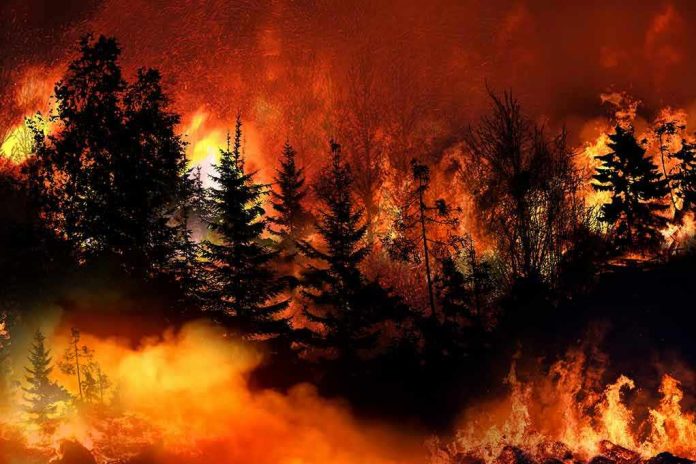
California firefighters battle a raging 9,000-acre wildfire with zero containment while Mother Nature threatens to unleash lightning strikes that could ignite dozens of new fires across the drought-stricken Sierra National Forest.
Story Snapshot
- Garnet Fire explodes to 9,170 acres in just three days with no containment achieved
- 800 firefighters deployed as evacuation orders force families from their homes
- Lightning-sparked thunderstorms threaten to ignite additional fires across the region
- Critical PG&E infrastructure at risk while Balch Camp community faces imminent danger
Rapid Fire Growth Overwhelms Suppression Efforts
The Garnet Fire ignited south of Rodgers Ridge in Sierra National Forest and has rapidly consumed 9,170 acres with zero containment as of August 27. California Interagency Incident Management Team 10, working alongside the U.S. Forest Service and Cal Fire, has deployed approximately 800 personnel to combat the blaze. Despite massive resource deployment, the fire continues its destructive march through the remote wilderness area located 60 miles east of Fresno, threatening both natural resources and critical infrastructure.
Multiple Evacuation Zones Under Threat
Fresno County officials issued evacuation orders for zones K27, K30, K31, K32-A, and K40, while evacuation warnings remain in effect for zones K28 and K29. The Balch Camp community faces particular danger as firefighters prioritize protecting this vulnerable area. Avocado Lake Park closed to support fire response operations, disrupting recreational activities for thousands of visitors. Local families forced to evacuate express frustration over repeated threats to their properties, highlighting the ongoing burden placed on rural communities by California’s increasingly dangerous fire seasons.
Lightning Threatens New Fire Ignitions
National Weather Service forecasters warn that approaching thunderstorms could spawn lightning strikes across the already fire-prone region, potentially igniting additional blazes. These weather conditions create a nightmare scenario for incident commanders who must prepare for multiple simultaneous fires while managing current suppression efforts. Erratic winds accompanying the storms further complicate firefighting operations, making aerial drops more dangerous and ground crews’ work less predictable. The combination of dry fuels, persistent drought conditions, and unstable weather patterns creates perfect conditions for catastrophic wildfire behavior.
Critical Infrastructure at Risk
Firefighters focus heavily on protecting PG&E power infrastructure and hydroelectric facilities threatened by the advancing flames. The utility company’s equipment vulnerability raises concerns about potential power outages affecting thousands of customers across Central California. The fire also threatens the Teakettle Experimental Forest, where researchers conduct long-term ecological studies critical to forest management science. Loss of this research facility would set back decades of scientific work aimed at understanding forest ecosystems and developing better wildfire prevention strategies.
Firefighters fight Calif. blaze as thunderstorms threatens new ignitions https://t.co/L5zJlNRKCu pic.twitter.com/oWboVKcSm7
— New York Post (@nypost) August 27, 2025
This incident underscores the escalating wildfire crisis plaguing California, where above-normal fire activity has already burned hundreds of thousands of acres statewide in 2025. The Sierra National Forest has endured multiple significant fires in recent years, including the devastating Creek Fire in 2020, demonstrating the region’s increasing vulnerability to catastrophic blazes that threaten both human communities and irreplaceable natural resources.
Sources:
Cal Fire Garnet Fire Incident Updates
Fresno County Garnet Fire Grows to More Than 9,000 Acres in Sierra National Forest
Firefighters Corral California Forest Blaze as Lightning Strikes Bring New Threats
NorCal Lightning Fires August 26, 2025







